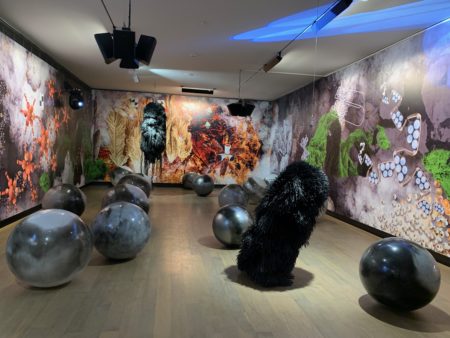Marlene Dietrich, actress turned singer, German turned American, sometimes feminine sometimes androgynous, invented the image of a multifaceted and liberated woman.
Her endless legs, those fingers elongated by a cigarette emitting a swirl of smoke, and her huge eyes framed by arching eyebrows, all bathed in a knowing light which ignites desire, making her ever desirable…
But Marlene Dietrich was not just this doll endowed with breath-taking looks.
Let’s not forget that she was one of the few German women to take the side of the American army during the Second World War.
All the craziest stories circulate around the elderly lady who died in Paris on the Avenue Montaigne, having long been immobile in her bed since she was no longer able to show her legs.
With photography exhibitions showing respectively in Paris at the Maison Européenne de la Photographie dedicated to Pierre Passebon’s collection, and in Washington at the National Portrait Gallery (organized in cooperation with Deutsche Kinemathek – Marlene Dietrich Collection Berlin), her grandson Peter Riva, who is a literary agent in the United States, reveals a little of her private life.
He is in charge of Marlene Dietrich’s moral rights.
Massy
When my brother Michel was young he couldn’t say Miss Dietrich. The nickname stuck.: “massy”
In the family we used to call my grandmother Massy, and in a professional setting we called her Miss Dietrich or Marlene.
.
Strict
She was from a Prussian family which, as you can imagine, was quite strict. Not mean, but strict.
Everything had to be done in the correct way: making the bed, for example. That’s typically Prussian. I got used to it from a very young age.
When she was in the kitchen, all it took was for someone to telephone her on professional business for her to physically transform.
She stood up straighter and she spoke with great precision. At moments like these it was forbidden to call her Massy.
Spending two hours with her was like spending a week with a normal person.
In New York we would sometimes go to her apartment after school while waiting for my mother to finish work. We had to sit very still. If Hemingway or Yul Brenner called in to see her, we had to stay sitting perfectly still in the living room with our books.
Cooking
She would cook for us from time to time. She was an excellent cook, it must be said.
Family
Marlene’s father was a kind of policeman. He was part of the emperor’s entourage. He came from an excellent family, but he was unreliable to say the least. Marlene used to say that only her mother’s second marriage was for love, but unfortunately her second husband died quite quickly.
Berlin
In Germany at the time Berlin was the most open city. Marlene was a true Berliner.
That’s why she wanted to be buried there.
Just after the Berlin wall came down she said, “Oh perhaps now I can consider returning.” A friend took photos of the cemetery where his mother was buried. Before that she had sent us to Switzerland and France looking for the cemetery that she had in her head. She had a very precise and romantic vision of it.
New York
Marlene continued to live in New York until 1963, at 993 Park Avenue.
Paris
When my mother Maria returned to Europe Marlene wanted to follow her. Around 1966 it was definitely Christian Dior or one of his collaborators who found her the apartment at 12 avenue Montaigne in Paris. It made sense for her to be just opposite the Hotel Plaza Athénée because she could call the concierge there who would send over the papers every day etc. The systems Marlene put in place…
Luxury
You must understand that luxury, for Marlene, had absolutely no value. All that mattered was that it was practical and effective. The apartment could have been near Orly… On Avenue Montaigne she could easily stop by at Courrège or Balmain…
Men
For Marlene, sex was not of great importance. She spoke very openly about it to my mother.
Love for a man or a woman, on the other hand, couldn’t be immoral and had nothing to do with sex.
We would often have lunch with Yul Brenner, one of her secret loves. At the time I personally could see no difference between her relationship with Yul and her relationship with Hemingway. Yet due to an instance of bad timing with Ernest and then with Marlene, there was no “affair” between them as such.
War
Marlene had a certain sense of duty. When she was with Jean Gabin during the Second World War she granted sexual favours to the soldiers and generals. She believed that they needed to have these moments of relaxation to ensure that they defeated the Nazis. For her, it was work. She was 100% dedicated to the cause.
You must also understand that during the 1930s we tried to encourage her to return to Germany. She refused point blank. She came from a Berlin milieu that was open to the arts, sexually liberated. She couldn’t change.
Pleasure
According to my mother, Jean Gabin was the only man who had satisfied Marlene sexually. But he could not bear her infidelity. The fact that she was married didn’t bother him. The fact that she was unfaithful to him by making love to generals, was insupportable. The correspondence between Gabin and Marlene has not yet been brought to light, but it will one day.
The End of Love
Marlene could not bear it when men became idiots.
Men who were madly in love changed for the worse.
Sternberg
Marlene instantly understood that he was a gifted man. They had a mutually supportive relationship which lasted for years.
An Imposing Figure
Marlene was a powerful woman. Around 1966 we were living in Gstaad in Switzerland. She sang at the Palace one night and after her performance there was a party thrown in her honour. All the in-crowd was there: Gunter Sachs, Brigitte Bardot, Richard Burton, Elizabeth Taylor… When Marlene entered through a little door the entire room became silent. I’ve only observed this phenomenon once before. It was with the Dalaï Lama during a party in New York. In both cases the crowds parted like the Red Sea.
Elegance
She wasn’t vain or coquettish. She had to present a perfect appearance for her work. Her reclusiveness in the last years of her life was due to the difficulty of maintaining an acceptable appearance in public. She was against plastic surgery. She never had it done. But Marlene was never scruffy. No blue jeans, for instance.
Marlene’s Keepsakes
Around 1992 we found a storage space containing piles of documents and keepsakes belonging to Marlene dating back to 1929. She never threw anything away, she kept letters, newspaper cuttings, personal items. When she died there were three lorries full of items. I have searched everywhere for a museum willing to offer the collection a home. Her entire history, including her clothes from 1929 to 1990. We haven’t had success with the Met in New York and there was no cinema museum in America. According to Berlin’s Senator for Cultural Affairs at the time, Ulrich Roloff-Momin: “Now that Germany is reunified, we need an example of an anti-Nazi.” They set up a lottery to buy the collection and they created the cinema museum in Berlin. Even from where she is, she continues her fight against the Nazis.
She disliked Coco Chanel because she thought she had made the wrong choice during the Second World War. Nevertheless, she admired her for the simplicity of her design.
False ideas about Marlene
She is systematically associated with a sensual, sexual side, and that annoys me.
She was a sexual dream for a lot of people.
But her own sexuality was not that important. And there is nothing wrong with a fan being sexually excited by Marlene, that’s ok. But what’s wrong is that he would think that she would be sexually excited by him.
All the photos were taken in Paris at Maison Europeenne de la photographie in the Pierre Passebon’s collection.
Until 25 February:
www.mep-fr.org/event/obsession-marlene.
Until 25 April:
Support independent news on art.
Your contribution : Make a monthly commitment to support JB Reports or a one off contribution as and when you feel like it. Choose the option that suits you best.
Need to cancel a recurring donation? Please go here.
The donation is considered to be a subscription for a fee set by the donor and for a duration also set by the donor.














